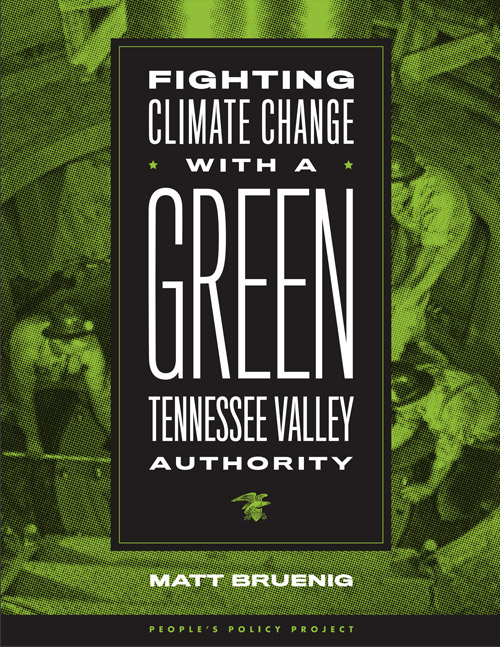People’s Policy Project has released its seventh major paper: “Fighting Climate with a Green Tennessee Valley Authority.” Matt Bruenig authored the paper. Jon White designed the paper.
The paper contains a brief proposal outlining how to use the Tennessee Valley Authority (TVA), a public power company that is fully owned by the federal government, to decarbonize electricity generation across the country. For the plan to be implemented, four amendments to the TVA Act should be made:
- The TVA Act should be amended to mandate that the TVA decarbonize all of its energy production by a certain date, e.g. 2027. TVA workers displaced by these decarbonization efforts should be given first priority for new jobs in the TVA’s clean energy installations.
- The TVA Act should be amended to authorize the TVA to operate all over the country, not just in its current service area.
- The TVA Act should be amended to establish that the installation of clean energy production across the country is one of the main objectives of the TVA.
- The TVA Act should be amended to permit the TVA to issue a new class of green power bonds to finance the capital expenditures required by its green energy buildout. These bonds, unlike those currently issued by the TVA, should be guaranteed by the full faith and credit of the federal government and there should be no limit on how many green power bonds the TVA can issue.
In addition to these reforms to the TVA Act, the paper also proposes that the federal government authorize and appropriate money to the TVA so that it can subsidize the price of its carbon-free electricity in order to ensure that it is competitive with carbon-based energy sources. This would ensure that electricity ratepayers do not directly shoulder the costs of the proposed clean energy build out.
The TVA, which was originally established during FDR’s New Deal, is the largest public power company in the country. In the last fiscal year, it produced and sold 160 billion kWh of electricity, which generated $11.2 billion of revenue and $1.1 billion of profit. It currently operates coal-fired plants, natural gas plants, oil-fired plants, a diesel generator site, nuclear plants, hydroelectric plants, 15 solar energy sites, and 1 wind energy site. Around 54 percent of its current energy production comes from non-carbon sources, with the bulk of that coming from nuclear.
Put simply: the TVA knows how to successfully produce large amounts of carbon-free electricity. So it should be up to the task of helping to decarbonize the electricity supply in its current service area and across the country.
The TVA also has a special power that no other climate policy can take advantage of: it issues its own bonds. Under current law, the TVA has the authority to issue its own debt (in the form of power bonds and discount notes) in order to finance its capital expenditures. This means it can raise money for clean energy investments without relying on Congressional appropriations. Its ability to issue debt is currently capped at $30 billion, but if Congress uncaps it and promises to guarantee the bonds with the full faith and credit of the federal government, the TVA would have an unlimited ability to unilaterally raise funds at low interest rates without formally affecting the federal government’s debt level.
A Green TVA would never be able to solve our climate problems by itself, but it would be a useful vehicle for expanding the supply of clean electricity, which must be part of any climate solution and a Green New Deal. The TVA is the federal government’s power company and the federal government should use its direct authority to make it into the kind of power company the country and the earth needs.

